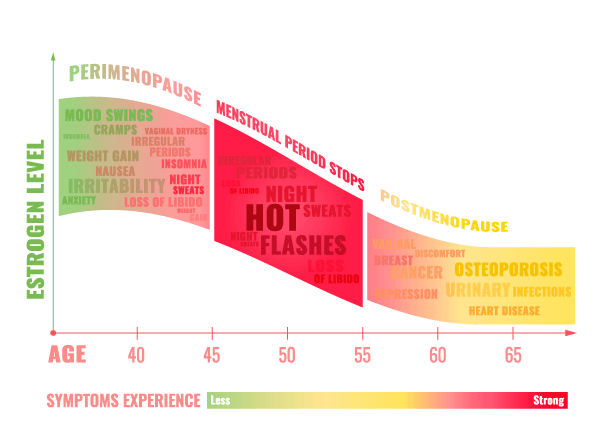Let's Take A "Pause"
"Wait—I'm barely 40, this can't be happening yet!" If you've found yourself wondering why you're suddenly sweating through your sheets, growing a gnarly whisker overnight, tearing up while watching commercials, or questioning your sanity, welcome to the club. From birth to the early days of perimenopause, navigating the unpredictability of menopause, or figuring out who you are on the other side, we break down the science and what's actually happening in your body.

The Early Years: Birth To Perimenopause
Did you know a woman is born with all the eggs she will ever have? At birth, a female baby has approximately 1-2 million eggs (oocytes). By puberty, this number naturally decreases to about 300,000-500,000. Throughout her reproductive life, only about 400-500 eggs will actually mature and be released during ovulation.
This predetermined egg supply has profound implications for fertility and menopause timing. Unlike men who continuously produce new sperm, a woman's reproductive potential is established before birth, with the quality and quantity of remaining eggs serving as the biological clock that eventually triggers menopause.
Pre-Perimenopause: Your Reproductive Years (Ages 12-40)
Hormonal Balance During peak reproductive years, your menstrual cycle is regulated by a delicate balance of hormones:
-
Estrogen rises during the first half of your cycle, causing the uterine lining to thicken
-
Luteinizing hormone (LH) surges at mid-cycle, triggering ovulation
-
Progesterone dominates the second half of your cycle, preparing the uterus for potential pregnancy
-
Follicle-stimulating hormone (FSH) stimulates the growth of ovarian follicles that contain eggs
FSH Levels by Age (Pre-Perimenopause)
-
Ages 12-30: 3-10 mIU/mL (during follicular phase)
-
Ages 30-35: 3-12 mIU/mL (slight elevation begins)
-
Ages 35-40: 5-15 mIU/mL (gradual increase as ovarian response diminishes)
Egg Count Timeline
-
At birth: 1-2 million eggs
-
At first menstrual period: 300,000-500,000 eggs
-
Age 30: Approximately 100,000-150,000 eggs
-
Age 35: Around 80,000 eggs
-
Age 40: Approximately 25,000 eggs
-
Post-menopause: Typically fewer than 1,000 eggs remain

The Transition Begins: Perimenopause
Perimenopause marks the beginning of your body's transition toward menopause. During this stage, ovarian function gradually declines, though fertility is still possible.
Key Biological Changes:
-
Declining ovarian reserve: Fewer eggs remain, and their quality diminishes
-
Erratic hormone production: Estrogen levels fluctuate unpredictably, sometimes with higher peaks and lower valleys than before
-
Irregular ovulation: You may skip ovulation in some cycles while having normal cycles in others
-
Variable cycle length: Periods may come closer together or further apart
Hormonal Markers:
-
FSH levels: Begin to rise, often exceeding 10-15 mIU/mL in early follicular phase
-
Estradiol (E2): Fluctuates widely, sometimes with periods of excess followed by deficiency
-
Inhibin B: Begins to decline, reducing the ovary's ability to suppress FSH
-
Anti-Müllerian Hormone (AMH): Decreases steadily, reflecting the diminishing ovarian reserve
Typical Age Range: Late 30s to early 50s (average onset: 42-45)
Average Duration: 4-10 years before reaching menopause
The Perimenopausal Experience
During perimenopause, your reproductive system is essentially "rewiring" itself. As ovarian function becomes less predictable, you may experience:
-
Cycle irregularity: The hallmark sign of perimenopause
-
Changes in menstrual flow: Periods may be heavier or lighter than usual
-
Hot flashes and night sweats: Affecting about 35-50% of perimenopausal women
-
Sleep disturbances: Often linked to nighttime hot flashes
-
Mood changes: Fluctuating hormones may affect neurotransmitters

The Definitive Transition: Menopause
Contrary to popular understanding, menopause isn't a prolonged state but a specific point in time marking the final menstrual period. This can only be identified retrospectively after 12 consecutive months without menstruation. Note, even if you haven't gotten your period for 10 consecutive months and get it on the 11th month, the timeline resets back to the beginning and you are still in Perimenopause.
Key Biological Markers:
-
Cessation of ovulation: The ovaries no longer release eggs
-
Permanent hormonal shift: Estrogen and progesterone production falls to minimal levels
-
FSH levels: Typically exceed 30-40 mIU/mL consistently
-
Estradiol levels: Usually below 30 pg/mL
Average Age: 51 years (range: 45-55 years)
Biological Significance: Menopause marks the end of reproductive capability and a shift to a new hormonal environment that affects multiple body systems.
Understanding the Permanent Hormone Change
At menopause, your ovaries stop functioning as reproductive organs and transition to a different role in your endocrine system. The dramatic reduction in estrogen affects tissues throughout your body, including:
-
Cardiovascular system: Changes in blood vessel elasticity and cholesterol metabolism
-
Skeletal system: Accelerated bone resorption exceeds formation
-
Genitourinary tract: Thinning of tissues and changes in pH balance
-
Central nervous system: Altered neurotransmitter activity affecting mood, sleep, and temperature regulation

Your New Normal: Post-Menopause
Post-menopause begins immediately after you've reached the 12-month mark without a period and continues for the rest of your life. During this stage, your body adapts to permanently lower levels of reproductive hormones.
Key Biological Changes:
-
Stable hormone levels: Unlike perimenopause, hormone levels become relatively constant, though at much lower levels than during reproductive years
-
FSH levels: Remain permanently elevated (often 40-100+ mIU/mL)
-
Minimal ovarian estrogen: The ovaries produce very little estrogen, though fat tissue continues to convert androgens to estrogen
-
Changes in body composition: Tendency toward central fat distribution
-
Accelerated bone loss: Most rapid in the first 5-7 years post-menopause
Age Range: Typically begins in early to mid-50s and continues throughout life
Physiological Adaptations: During post-menopause, your body undergoes a series of adaptations to function in a low-estrogen environment. These changes include:
-
Redistribution of fat: Increased abdominal adiposity
-
Changes in collagen: Decreased skin elasticity and density
-
Adjusted metabolism: Typically slower metabolic rate
-
Immune system adjustments: Changes in inflammatory response
Health Considerations
The post-menopausal hormonal environment brings specific health considerations:
-
Bone health: Increased risk of osteopenia and osteoporosis due to accelerated bone loss
-
Cardiovascular health: Changed lipid profiles and vascular responsiveness
-
Urogenital health: Increased likelihood of vaginal dryness and urinary issues
-
Mental health: Potential changes in cognitive patterns and mood stability





